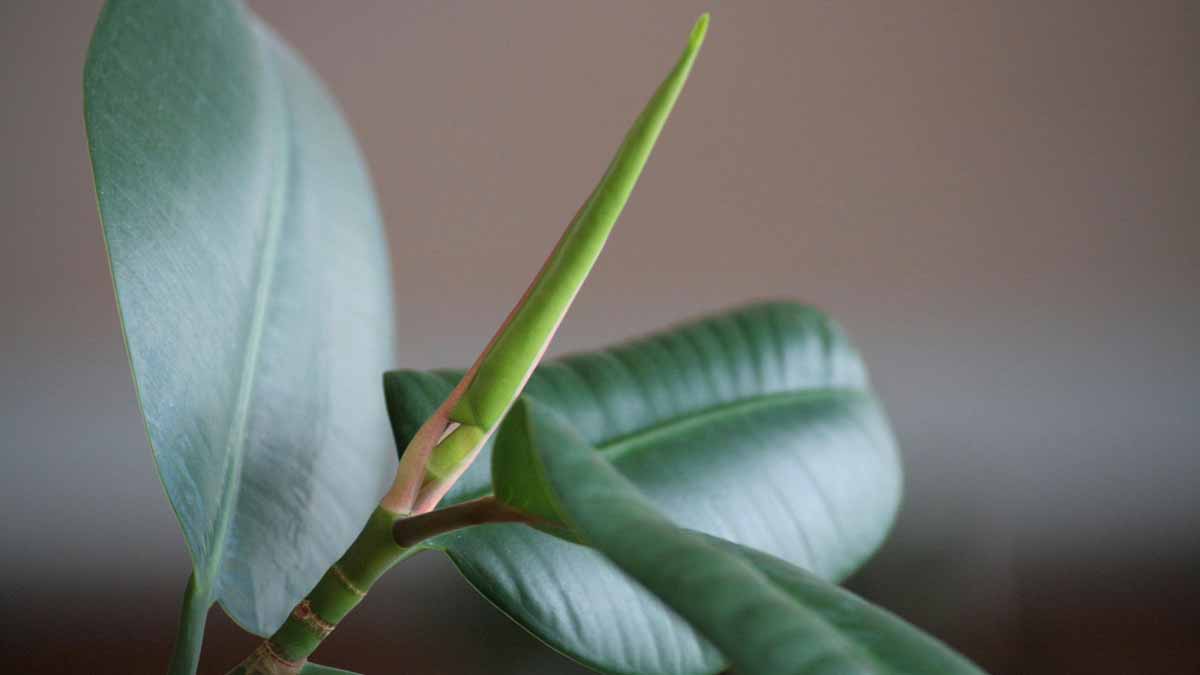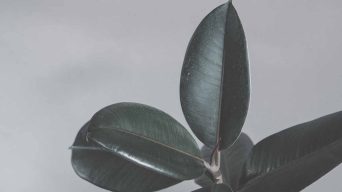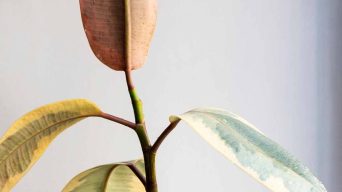Rubber plant leaves curling may be caused by improper watering, either by overwatering or underwatering. Check soil moisture and adjust your watering schedule. Low humidity levels and pests can also be contributing factors.
Rubber plants (ficus elastica) are popular houseplants because they are easy to care for and can tolerate a wide range of growing conditions. However, even the hardiest of plants can experience problems from time to time.
One common issue that rubber plant owners face is leaf curling.
Leaf curling can be caused by several factors, including improper watering, too much or too little light, extreme temperatures, or pests.
If you notice your rubber plant leaves curling, take a closer look at the plant and try to identify the cause.
Once you know what is causing the leaf curling, you can take steps to correct the problem and get your indoor plant back on track.
Why Are My Rubber Plant Leaves Curling, and How Can You Fix It?
Several reasons your rubber plant’s leaves might start to curl.
Here are some of the most common causes of curling leaves in rubber plants, along with tips on fixing the problem.
1. Underwatering
One of the most common reasons rubber plant leaves curl is underwatering.
Rubber plants are drought tolerant and can go long periods without water. Still, they will start showing signs of stress if not watered regularly.
If your rubber plant’s leaves are starting to curl, likely, that the plant is not getting enough water.
When the ficus plant is not getting enough water, it will start to pull moisture from the leaves, causing them to curl and wilt.
How To Fix It
Rubber plants are drought-tolerant but need to be watered regularly.
To prevent curling leaves, water your rubber fig when the top inch of the soil is dry.
Be sure to give the plant a deep watering so that the water can reach the roots.
You may need to water more deeply if you still see leaf curling after increased watering frequency.
2. Overwatering
While underwatering is a common cause of curling leaves in rubber plants, overwatering can also be problematic.
Rubber plants are susceptible to root rot, which can occur when the roots are constantly wet.
If your plant’s leaves are curling and wilting, you are likely overwatering your rubber plant.
Overwatering is commonly caused by watering too often or using a pot with inadequate drainage.
How To Fix It
To prevent overwatering, only water your rubber plant when the top inch of the soil is dry.
In general, rubber plants need to be watered about once a week.
Be sure to empty the drip tray after watering so the plant’s roots are not sitting in water.
If you think your rubber bush is suffering from root rot, you must repot the plant in fresh, well-draining soil.
3. Too Much Light
Rubber plants need bright, indirect light to thrive.
While they can tolerate some direct sunlight, too much sun can cause the leaves to curl.
If your rubber tree is in a sunny spot, the leaves are likely curling to protect the plant from the intense heat and light.
When rubber plant leaves curl, it reduces the surface area exposed to the light, which helps protect the plant from damage.
Curling also helps reduce the amount of water lost through evaporation.
While too much light can cause rubber plant leaves to curl, this is not necessarily bad.
Curling helps protect the plant from damage and helps conserve water, both of which are important for the plant’s health.
How To Fix It
If your rubber plant’s leaves are curling due to too much light, you can move the plant to a new location.
Choose a spot with bright indirect light, and avoid direct sunlight.
Rubber plants do best when grown as indoor plants near an east- or west-facing window.
This will give the plant the bright light it needs without exposing it to too much direct sunlight.
If you cannot move the plant, you can try to filter the light with a sheer curtain.
4. Heat Stress
In addition to light, rubber plants can also be sensitive to heat.
While rubber plants can tolerate some degree of heat stress, protecting them from excessive heat is essential.
The leaves will start curling to conserve water if the air is too hot or dry.
Heat stress is most common in the summer, but it can also be a problem in the winter if the plant is near a heating vent.
Extreme temperatures can cause houseplant leaves to turn brown and drop off.
How To Fix It
To protect your rubber plant from heat stress, ensure the room temperature is between 65 and 75 degrees Fahrenheit.
Avoid placing the plant near a heating vent or in direct sunlight.
If the air in your home is particularly dry, you can increase the humidity around the plant by placing it on a pebble tray or using a humidifier.
In the summer months, you can also mist the plant with water to help increase the humidity around it.
5. Pest Infestation
Pest infestation is one of rubber plants’ most common causes of leaf curling.
Rubber plants are particularly susceptible to mealybugs, aphids, and spider mites.
Mealybugs and aphids are tiny, sap-sucking insects that can cause the leaves to curl and turn yellow.
Spider mites are tiny spider-like creatures that feed on the plant’s leaves.
They can cause the leaves to curl, turn yellow, and eventually drop off the plant.
Pest infestations are often most severe in the spring and summer months.
How To Fix It
If you think your rubber plant has a pest infestation, the best thing you can do is treat the plant with insecticidal soap or neem oil.
You will need to apply the treatment every few days for several weeks to get rid of the pests.
Once the pests are gone, keep an eye out for new infestations.
You can also prevent pests by keeping your rubber plant healthy and stress-free.
A healthy rubber plant is better able to withstand an infestation and is less likely to be damaged by pests.
6. Nutrient Deficiency
Another common cause of leaf curling in rubber plants is nutrient deficiency.
Rubber plants need a balance of nitrogen, phosphorus, and potassium to stay healthy.
The plant will show signs of stress if it lacks any of these nutrients.
One of the most common signs of a nutrient deficiency is leaf curling.
The leaves will turn yellow or brown and curl at the edges.
A nutrient deficiency is most likely to occur in plants grown in soil that lack nutrients.
It can also be a problem if the plant is not getting enough water or if the roots are damaged.
How To Fix It
If you think your rubber plant has a nutrient deficiency, the best thing you can do is fertilize the plant.
Choose a fertilizer that is high in nitrogen and potassium and low in phosphorus.
Apply the fertilizer to the soil around the plant according to the package directions.
You should also make sure the plant is getting enough water.
Water the plant when the top inch of soil is dry.
If the roots of the plant are damaged, you may need to repot it in fresh soil.
7. Compacted Soil
Another common cause of leaf curling in rubber plants is compacted soil.
Rubber plants need well-drained, loose soil to stay healthy.
If the soil is too compacted, the roots will not get the oxygen and water they need to thrive. This can cause the leaves to curl, turn yellow, and drop off the plant.
Compacted soil is most likely to be a problem in plants that are grown in pots.
When the roots of a plant are confined to a small space, they are more likely to become compacted.
How To Fix It
If you think your rubber plant has compacted soil, the best thing you can do is repot the plant in fresh, loose soil.
Choose a pot that is just big enough to accommodate the plant’s roots.
Be sure to loosen the roots before you replant them.
You can add perlite or vermiculite to the potting mix to help improve drainage.
8. Cold Temperature
Another common cause of leaf curling in rubber plants is cold temperatures. This is because rubber plants are native to tropical climates and cannot tolerate temperatures below 50 degrees Fahrenheit.
When rubber plants are exposed to cold temperatures, the cell walls in their leaves begin to break down. This causes the leaves to curl up and turn brown, eventually leading to leaf drop.
While leaf curling is mostly a cosmetic issue, it can cause stress to the plant and lead to other problems if the temperature remains low for an extended period.
How To Fix It
If you think your rubber plant is experiencing leaf curling due to cold temperatures, the best thing you can do is move the plant to a warmer location.
Be sure to choose a location that receives indirect sunlight.
You should also make sure the plant is protected from drafts and wind.
If the temperature is only slightly below 50 degrees, you can raise the temperature around the plant by using a heat lamp or placing it on a warm surface.
9. Chemical Damage
Another common cause of rubber plant leaves curling is chemical damage.
This can be caused by using insecticide, herbicide, or too much fertilizer on the plant.
It can also be caused by exposing the plant to cigarette smoke or other pollutants.
Chemical damage will cause the plant leaves to turn yellow or brown and curl at the edges.
The leaves may also have burns or spots on them.
How To Fix It
If you think chemicals have damaged your rubber plant, the best thing you can do is flush the soil with water. This will help to remove any residual chemicals from the soil.
You should also remove any damaged leaves from the plant.
If the damage is caused by too much fertilizer, you can try diluting it with water before applying it to the plant.
You should also make sure the plant is getting enough water.
10. Transplant Shock
Another common cause of rubber plant leaf curling is transplant shock.
Transplant shock is most likely to occur when a plant is moved to a new pot or location.
It can also occur if the plant’s roots are disturbed when repotting.
When a plant experiences transplant shock, the leaves will turn yellow or brown and curl up at the edges.
The houseplant may also lose its leaves.
How To Fix It
If you think your rubber tree plant is experiencing transplant shock, the best thing you can do is give it time to adjust to its new environment.
Be sure to water the plant regularly and keep it in a location that receives bright indirect light.
You should also avoid fertilizing the plant for a few weeks.
If the plant is not improving after a few weeks, you can try repotting it in fresh soil.
How To Prevent Leaf Curling In Rubber Plants
You can do a few things to prevent curled leaves in rubber plants.
The best way to prevent the problem is to provide the ficus elastica plant with the proper care.
Here are a few tips:
- Water the plant regularly and make sure the soil is evenly moist
- Keep the plant in a location that receives bright indirect light
- Place the plant in an area with a consistent temperature
- Avoid using insecticide, herbicide, or too much fertilizer
- Do not disturb the roots when repotting
- Give the plant time to adjust to its new environment after transplanting
- Fertilize the plant monthly during the growing season
- Protect the plant from drafts and cold temperatures
By following these tips, you can help to prevent leaf curling in rubber plants.
Final Thoughts
Rubber plant leaves curling is a common problem that several factors can cause.
The best way to prevent the problem is to provide the ficus elastica plant with the proper care.
If you think your rubber plant is experiencing leaf curling, the best thing you can do is try to identify the cause of the problem and take steps to fix it.







